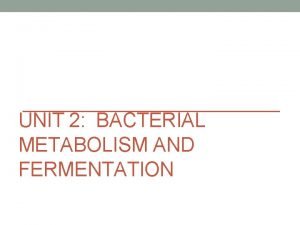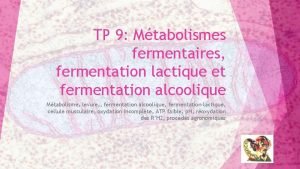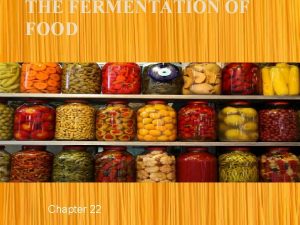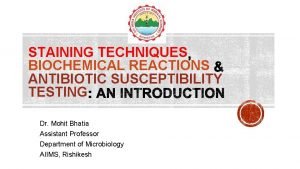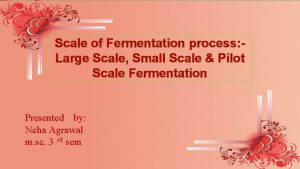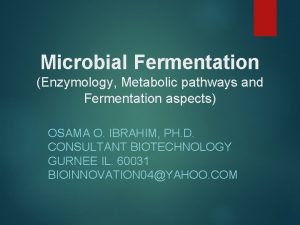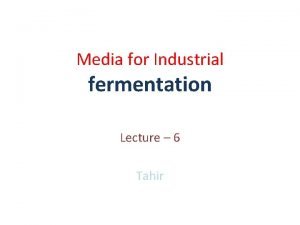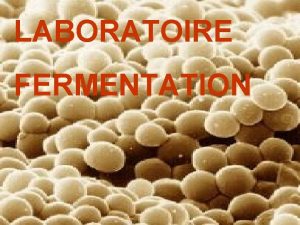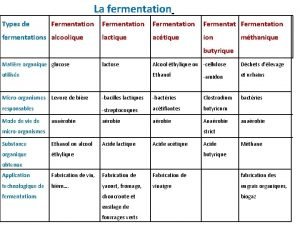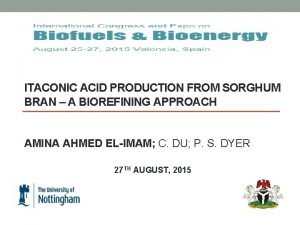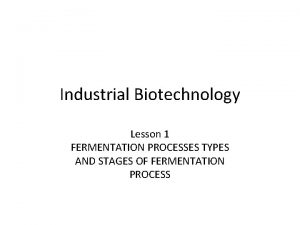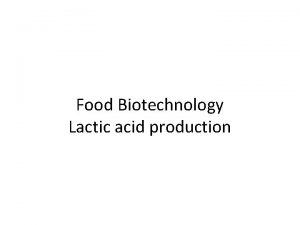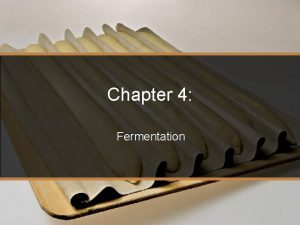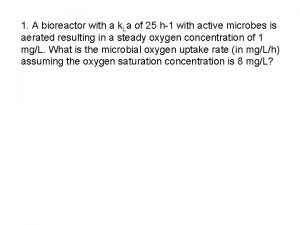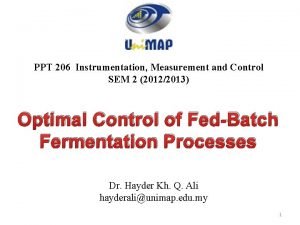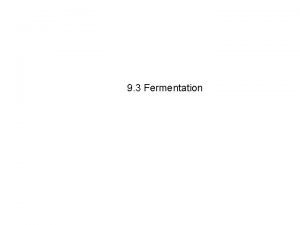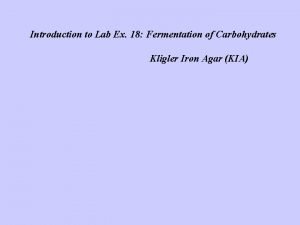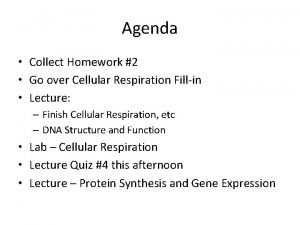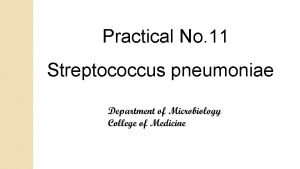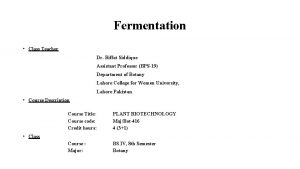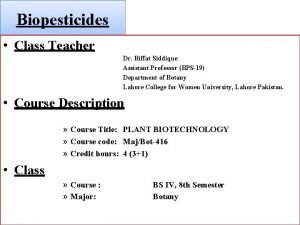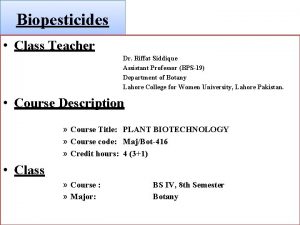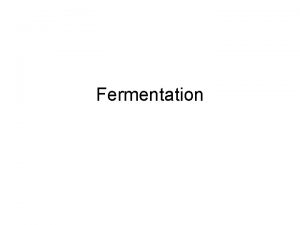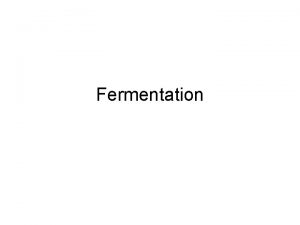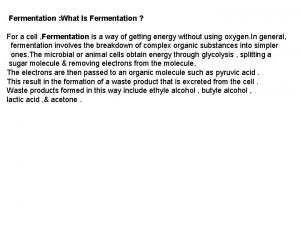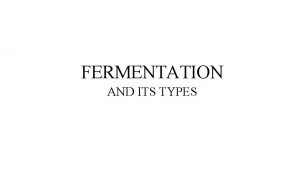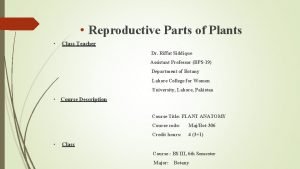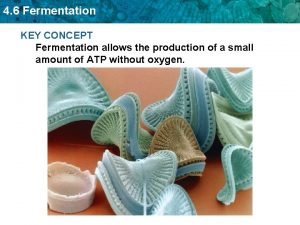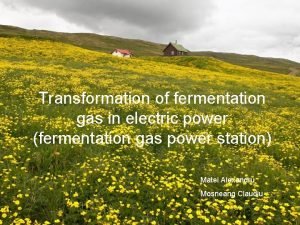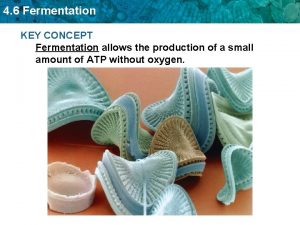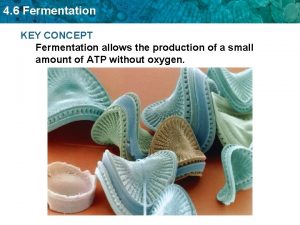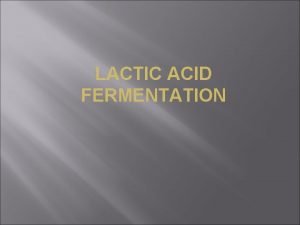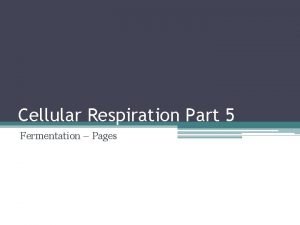Fermentation Class Teacher Dr Riffat Siddique Assistant Professor







































- Slides: 39

Fermentation • Class Teacher Dr. Riffat Siddique Assistant Professor (BPS-19) Department of Botany Lahore College for Women University, Lahore Pakistan. • Course Description Course Title: Course code: Credit hours: PLANT BIOTECHNOLOGY Maj/Bot-416 4 (3+1) Course : Major: BS IV, 8 th Semester Botany • Class

Introdution To Fermentation • Fermentation is a metabolic process that converts sugar to acids, gases or alcohol. It occurs in yeast and bacteria, and also in oxygen-starved (Deficient ) muscle cells. Fermentation, chemical process by which molecules such as glucose are broken down anaerobically. • More broadly, fermentation is the foaming (Un-healthy) that occurs during the manufacture of wine and beer, a process at least 10, 000 years old. The frothing results from the evolution of carbon dioxide gas, though this was not recognized until the 17 th century. • French chemist and microbiologist Louis Pasteur in the 19 th century used the term fermentation in a narrow sense to describe the changes brought about by yeasts and other microorganisms growing in the absence of air (anaerobically); he also recognized that ethyl alcohol and carbon dioxide are not the only products of fermentation.

Fermentation • Definition: Fermentation is the chemical transformation of organic substances into simpler compounds by the action of enzymes, complex organic catalysts, which are produced by microorganisms such as molds, yeasts, or bacteria. • Enzymes act by hydrolysis, a process of breaking down or predigesting complex organic molecules to form smaller (and in the case of foods, more easily digestible) compounds and nutrients.

HISTORY OF FERMENTATION • Fermentation is a natural process. People applied fermentation to make products such as wine, mead (Made of Fermented honey and water), cheese and beer long before the biochemical process was understood. • In the 1850 s and 1860 s Louis Pasteur became the scientist to study fermentation when he demonstrated fermentation was caused by living cells. • The first solid evidence of the living nature of yeast appeared between 1837 and 1838 when it was concluded as a result of microscopic investigations that yeast was a living organism that reproduced by budding. • The word "yeast, " it should be noted, traces its origins back to the Sanskrit word meaning "boiling. " It was perhaps because wine, beer, and bread were each basic foods in Europe, that most of the early studies on fermentation were done on yeasts, with which they were made. Soon bacteria were also discovered; the term was first used in English in the late 1840 s, but it did not come into general use until the 1870 s, and then largely in connection with the new germ theory of disease.

HISTORY OF FERMENTATION • The view that fermentation was a process initiated by living organisms soon aroused fierce criticism from the finest chemists of the day. • A long battle ensued, and while it was gradually recognized that yeast was a living organism, its exact function in fermentations remained a matter of controversy. • The chemists still maintained that fermentation was due to catalytic action or molecular vibrations. The debate was finally brought to an end by the great French chemist Louis Pasteur (1822 -1895) who, during the 1850 s and 1860 s, in a series of classic investigations, proved conclusively that fermentation was initiated by living organisms. • In 1857 Pasteur showed that lactic acid fermentation is caused by living organisms.

HISTORY OF FERMENTATION • In 1860 he demonstrated that bacteria cause souring in milk, a process formerly thought to be merely a chemical change, and his work in identifying the role of microorganisms in food spoilage led to the process of pasteurization. • He defined fermentation (incorrectly) as "Life without air, " but correctly showed specific types of microorganisms cause specific types of fermentations and specific end products. In 1877 the era of modern medical bacteriology began when Koch (a German physician; 1843 - 1910) and Pasteur showed that the anthrax bacillus caused the infectious disease anthrax. • This epic discovery led in 1880 to Pasteur's general germ theory of infectious disease, which postulated for the first time that each such disease was caused by a specific microorganism. Koch also made the very significant discovery of a method for isolating microorganisms in pure culture.

TRADITIONAL FERMENTATION • Traditional fermentation technology, as mentioned in the literary texts, is several thousand years old. • The fermentation technology employed a variety of processes and was put to a large number of uses. • Fermentation has been widely used for the production of a wide variety of substances that are highly beneficial to individuals and industry. • Over the years, fermentation techniques have gained immense importance due to their economic and Environmental advantages. • Ancient techniques have been further modified and refined to maximize productivity. • This has also involved the development of new machinery and processes. Two broad fermentation techniques have emerged as a result of this rapid development: • 1. Solid State Fermentation (SSF). 2. Submerged Fermentation (Sm. F).

SOLID STATE FERMENTATION • Solid state (substrate) fermentation (SSF) has been defined as the fermentation process occurring in the absence or near-absence of free water. • Solid state fermentation (SSF) is another method used for the production of enzymes, which involves the cultivation of microorganisms on a solid substrate, such as grains, rice and wheat. • SSF employs natural raw materials as carbon source such as assava, barley, wheat bran, sugarcane bagasse.

SELECTION OF MICRO-ORGANISM AND SUBSTRATE • Selection of Micro-organism is one of the key factor for improved yields of the product. • Bacteria, Yeast and Filamentous Fungi can be used. • Filamentous Fungi has shown better results growing in the solid substrate fermentation. • Substrate also plays important role in determining the growth of micro- organisms, there by increasing the product yield. • Substrate is chosen such a way that it should provide physical support as well as nutrients to the growing culture.

APPLICATIONS Applications of SSF as described before, Solid State fermentation is being employed in various fields ranging from pharmacology to bioremediation, covering various aspects of biodiversity conservation. • Production of Industrial Enzymes • Production of Bio pesticides • In Bioleaching • In Bioremediation

ADVANTAGES OF SSF

SUBMERGED FERMENTATION • In the submerged process, the substrate used for fermentation is always in liquid state which contains the nutrients needed for growth. • The fermentor which contains the substrate is operated continuously and the product biomass is continuously harvested from the fermenter by using different techniques then the product is filtered or centrifuged and then dried. • Submerged fermentation is a method of manufacturing bio molecules in which enzymes and other reactive compounds are submerged in a liquid such as alcohol, oil or a nutrient broth.

APPLICATIONS • Submerged Fermentation (Sm. F)/Liquid Fermentation (LF). • Sm. F utilizes free flowing liquid substrates, such as molasses and broths. • This fermentation technique is best suited for microorganisms such as bacteria that require high moisture. • An additional advantage of this technique is that purification of products is easier.

TYPES OF FERMENTATION • There are basic two type of fermentation: • Ethanol fermentation, is the alcoholic fermentation, is the production of ethanol and carbon dioxide • • Lactic acid fermentation refers to two means of producing lactic acid: • Homolactic fermentation is the production of lactic acid exclusively • Heterolactic fermentation is the production of lactic acid as well as other acids and alcohols.

ETHANOL FERMENTATION • The chemical equation below shows the alcoholic fermentation of glucose, whose chemical formula is C 6 H 12 O 6. • One glucose molecule is converted into two ethanol molecules and two carbon dioxide molecules. • C 6 H 12 O 6 → 2 C 2 H 5 OH + 2 CO 2 • C 2 H 5 OH is the chemical formula for ethanol. • Before fermentation takes place, one glucose molecule is broken down into two pyruvate molecules. This is known as glycolysis. • Ethanol fermentation, also called alcoholic fermentation, is a biological process which converts sugars such as glucose, fructose, and sucrose into cellular energy, producing ethanol and carbon dioxide as a side-effect. • Ethanol fermentation has many uses, including the production of alcoholic beverages, the production of ethanol fuel, and bread cooking.

ALCOHOLIC FERMENTATION

LACTIC ACID FERMENTATION • It is a metabolic process by which glucose and other six-carbon sugars (also, disaccharides of six- carbon sugars, e. g. sucrose or lactose) are converted into cellular energy and the metabolite lactate. • If oxygen is present in the cell, many organisms will bypass fermentation and undergo cellular respiration; however, facultative anaerobic organisms will both ferment and undergo respiration in the presence of oxygen. • Lactate dehydrogenase catalyzes the interconversion of pyruvate and lactate with concomitant interconversion of NADH and NAD+.

LACTIC ACID FERMENTATION

HOMOLACTIC FERMENTATION • It is the simplest type of fermentation. • The pyruvate from glycolysis undergoes a simple redox reaction, forming lactic acid. • Overall, one molecule of glucose (or any six-carbon sugar) is converted to two molecules of lactic acid: C 6 H 12 O 6 → 2 CH 3 CHOHCOOH • It occurs in the muscles of animals when they need energy faster than the blood can supply oxygen. It also occurs in some kinds of bacteria (such as lactobacilli) and some fungi.

HETEROLACTIC FERMENTATION • In heterolactic fermentation, where some lactate is further metabolized and results in ethanol and carbon dioxide (via the phosphoketolase pathway), acetate, or other metabolic products, e. g. : C 6 H 12 O 6 → CH 3 CHOHCOOH + C 2 H 5 OH + CO 2 • Heterolactic fermentation is in a sense intermediate between lactic acid fermentation, and other types, e. g. alcoholic fermentation.


FERMENTATION PROCESS

BATCH FERMENTATION • Batch fermentation ; Nutrients are added in the fermentation for the single time only the growth continuous until the particular nutrient are exhausted.





BACTERIA-POPULATION GROWTH CURVE

CHARACTERISTICS OF A BATCH FERMENTATION SYSTEM

CONTINUOUS FERMENTATION

CONTINUOUS FERMENTATION

DISADVANTAGES OF CONTINUOUS FERMENTATION

FED BATCH FERMENTATION

FED BATCH FERMENTATION


ADVANTAGES • 1. Preserves and enriches food, improves digestibility, and enhances the taste and flavour of foods. • 2. Potential of enhancing food safety by controlling the growth and multiplication of a number of pathogens in foods. • 3. Important contribution to human nutrition, particularly in developing countries, where economic problems pose a major barrier to ensuring food safety. • 4 - Low energy consumption due to the mild operating conditions relatively low capital and operating costs relatively simple technologies. • 5 - They cause highly specific and controlled changes to foods by using enzymes. • 6 - Preservation and detoxification of the food. • 7 - Waste treatment. • 8 - Health related product.

DISADVANTAGES • Hazardous microbial contamination always exist in fermented food. • The uneven distribution of salt in lactic acid fermented fish products and contamination of Aspergillus flavus in traditional starter cultures for rice wine and soybean sauce result in severe food poisoning incidences. • Health (obesity, cancer).


SOURCES/REFERENCES • https: //www. slideshare. net/Abdul. Rahman. Shaikh 2/ferment ation-72117793 • https: //www. slideshare. net/Diya. Khan 11/fermentation 76494495 • https: //www. slideshare. net/shyleshmurthy/fermentationtypes
 Yusra siddique
Yusra siddique Qualities starting with n
Qualities starting with n Promotion from assistant to associate professor
Promotion from assistant to associate professor Fok ping kwan
Fok ping kwan Anwser
Anwser The girl drove the blue car passive voice
The girl drove the blue car passive voice Requirements for erf teacher 3
Requirements for erf teacher 3 Good afternoon student
Good afternoon student Nutrition in bacteria
Nutrition in bacteria Tp fermentation alcoolique saccharomyces cerevisiae
Tp fermentation alcoolique saccharomyces cerevisiae Objectives of fermentation
Objectives of fermentation Stately motility definition
Stately motility definition Pilot scale fermenter
Pilot scale fermenter Classification of fermentation
Classification of fermentation Fenicilin
Fenicilin Organism of lactic acid fermentation
Organism of lactic acid fermentation Fermentation des glucides
Fermentation des glucides Types de fermentation
Types de fermentation Itaconic acid fermentation
Itaconic acid fermentation Fermentation types
Fermentation types Factors affecting fermentation
Factors affecting fermentation Factors affecting fermentation
Factors affecting fermentation Antigenic structure of e coli
Antigenic structure of e coli Difference between submerged and solid state fermentation
Difference between submerged and solid state fermentation Alcoholic fermentation steps
Alcoholic fermentation steps Factors affecting fermentation
Factors affecting fermentation Cellular respirationn
Cellular respirationn What are the net products of the krebs cycle
What are the net products of the krebs cycle Formula for lactic acid fermentation
Formula for lactic acid fermentation Heterolactic fermentation pathway
Heterolactic fermentation pathway Measurement and control of fermentation parameters ppt
Measurement and control of fermentation parameters ppt Fermentation lactique équation
Fermentation lactique équation Section 7-1 glycolysis and fermentation answer key
Section 7-1 glycolysis and fermentation answer key Carbohydrates fermentation
Carbohydrates fermentation Fermentation in microorganisms
Fermentation in microorganisms Carbohydrates fermentation
Carbohydrates fermentation Carbohydrates fermentation
Carbohydrates fermentation Lactic acid fermentation
Lactic acid fermentation Excessive use of nitrogen fertilizers may result in
Excessive use of nitrogen fertilizers may result in S
S








